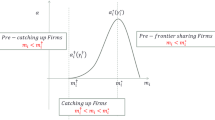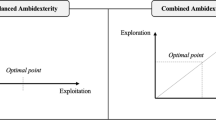Abstract
Mixed evidence has been found regarding how locating in a cluster or a park affects firms’ performance. This paper investigates how locating in different types of clusters and parks interacted by firm size or in-house R&D capability affects a firm’s innovation. Empirically testing the research hypotheses by the data of 165 Taiwan’s manufacturing firms in the information and communication technology sector and taking policy-driven parks (e.g., science parks and industrial parks) and spontaneously clusters as examples, we find that in emerging economies, firms with inferior in-house R&D capability gain more innovation benefits by locating in a science park or a spontaneous cluster while smaller firms gain more innovation benefits by locating in an industry park or a spontaneous cluster. Moreover, our findings also suggest that locating in a science park, smaller firms benefit more than larger firms in terms of innovation performance whereas larger firms benefit more than smaller firms in terms of market performance. The findings suggest that in emerging economies, compared to larger firms, smaller firms are less influenced by negative spillover effect when locating in clusters or parks.
Similar content being viewed by others
Notes
This can be interpreted as larger firms gain less in innovation in a cluster than smaller firms.
This hypothesis can be interpreted reversely, i.e., the less the in-house R&D, the less losses in innovation due to negative spillover effect.
References
Acs, Z. J., Anselin, L., & Varga, A. (2002). Patents and innovation counts as measures of regional production of new knowledge. Research Policy, 31, 1069–1085.
Acs, Z., & Audretsch, D. B. (1990). Innovation and small firms. Cambridge: MIT Press.
Almeida, P., & Phene, A. (2004). Subsidiaries and knowledge creation: The influence of the MNC and host country on innovation. Strategic Management Journal, 25, 847–864.
Alsleben, C. (2005). The downside of knowledge spillovers: An explanation for the dispersion of high-tech industries. Journal of Economics, 84(3), 217–248.
Arauzo Carod, J. M., & Manjón Antolín, M. C. (2004). Firm size and geographical aggregation: An empirical appraisal in industrial location. Small Business Economics, 22, 299–312.
Audretsch, D. B. (1998). Agglomeration and the location of innovative activity. Oxford Review of Economic Policy, 14(2), 18–29.
Audretsch, D. B., & Feldman, M. P. (1996). R&D spillovers and the geography of innovation and production. American Economic Review, 86(3), 630–645.
Baptista, R., & Swann, P. (1998). Do firms in clusters innovate more? Research Policy, 27, 525–540.
Bates, T., & Nucci, A. (1989). An analysis of small business size and rate of discontinuance. Journal of Small Business Management, 27, 1–7.
Blau, J. (1999). Research collaborations drive global telecoms industry. Research Technology Management, 42(4), 4–5.
Bozdogan, H. (1987). Model selection and Akaike’s Information Criterion (AIC): the general theory and its analytical extensions. Psychometrika, 52, 345–370.
Brush, C. G., Edelman, L. F., & Manolva, T. S. (2008). The effects of initial location, aspirations, and resources on likelihood of first sale in nascent firms. Journal of Small Business Management, 46(2), 159–182.
Caloghirou, Y., Kastelli, I., & Tsakanikas, A. (2004). Internal capabilities and external knowledge sources: Complements or substitutes for innovative performance. Technovation, 24, 29–39.
Chang, S. J., & Park, S. (2005). Types of firms generating network externalities and MNCs’ co-location decisions. Strategic Management Journal, 26(7), 595–615.
Chiesa, V., & Chiaroni, D. (2005). Industrial clusters in biotechnology—driving forces, development processes and management practices. London: Imperial College Press.
Chung, W., & Kalnins, A. (2001). Agglomeration effects and performance: A test of the Texas lodging industry. Strategic Management Journal, 22(10), 969–988.
Cohen, W. M., Levin, R. C., & Mowery, D. C. (1987). Firm size and R & D intensity: A re-examination. The Journal of Industrial Economics, 35(4), 543–565.
Cohen, W. M., & Levinthal, D. A. (1990). Absorptive capacity: A new perspective on learning an innovation. Administrative Science Quarterly, 35(1), 128–152.
Cohen, W. M., Nelson, R. R., & Walsh, J. P. (2002). Links and impacts: The influence of public research on industrial R&D. Management Science, 48(1), 1–23.
Cooke, P. (2002). Regional innovation systems: General findings and some new evidence from biotechnology clusters. Journal of Technology Transfer, 27(1), 133–145.
Das, T. K., & Teng, B. S. (1998). Resource and risk management in the strategic alliance making process. Journal of Management, 24(1), 21–42.
Dierdonck, R. V., Debackere, K., & Rappa, M. A. (1991). An assessment of science parks: Towards a better understanding of their role in the diffusion of technological knowledge. R&D Management, 21(2), 109–124.
Felderman, M. (2003). The locational dynamics of the US biotech industry: Knowledge externalities and the anchor hypothesis. Industry & Innovation, 10(3), 311–329.
Ferguson, R., & Olofsson, C. (2004). Science parks and the development of NTBFs—location, survival and growth. Journal of Technology Transfer, 29, 5–17.
Freeman, C. (1987). Technology and economic performance: Lessons from Japan. London: Pinter.
Galbraith, C. S., Rodriguez, C. L., & DeNoble, A. F. (2008). SME competitive strategy and location behavior: An exploratory study of high-technology manufacturing. Journal of Small Business Management, 46(2), 183–202.
Gambardella, A. (1992). Competitive advantages from in-house scientific research: The US pharmaceutical industry in the 1980s. Research Policy, 21, 391–407.
Gulati, R., Nohria, N., & Zaheer, A. (2000). Strategic networks. Strategic Management Journal, 21(3), 203–215.
Hagedoorn, J., & Cloodt, M. (2003). Measuring innovative performance: Is there an advantage in using multiple indicators. Research Policy, 32, 1365–1379.
Hewitt-Dundas, N. (2006). Resource and capability constraints to innovation in small and large plants. Small Business Economics, 26, 257–277.
Huang, K. F., & Yu, C. M. J. (2011). The effect of competitive and non-competitive R&D collaboration on firm innovation. Journal of Technology Transfer, 36(4), 383–403.
Humphrey, J., & Schmitz, H. (1996). The triple approach to local industrial policy. World Development, 24(12), 1859–1877.
Ireland, R. D., & Hitt, M. A. (1999). Achieving and maintaining strategic competitiveness in the 21st century. Academy of Management Executive, 15(1), 43–57.
Kalnins, A., & Chung, W. (2004). Resource-seeking agglomeration: A study of market entry in the lodging industry. Strategic Management Journal, 25, 689–699.
Keeble, D., & Wilkinson, F. (1999). Collective learning in regionally clustered high technology SMEs in Europe. Regional Studies, 33, 295–303.
Keil, T., Schildt, M. M. H., & Zahra, S. A. (2008). The effect of governance modes and relatedness of external business development activities on innovative performance. Strategic Management Journal, 29(8), 895–907.
Kennedy, K. J., & Holmfeld, J. D. (1989). A corporate R&D metric. International Journal of Technology Management, 4(6), 665–672.
Lackman, C. L. (2005). The comparative influence of government funding by the US Commerce Department’Advanced Technology Program and private funding on the marketing strategy of the high-tech firms. Journal of Nonprofit & Public Sector Marketing, 13(1/2), 179–198.
Lee, J., & Park, C. (2006). Research and development linkages in a national innovation system: Factors affecting success and failure in Korea. Technovation, 26(9), 1045–1054.
Lichtenthaler, U. (2007). The drivers of technology licensing: An industry comparison. California Management Review, 49, 67–89.
Link, A. N., & Link, K. R. (2003). On the growth of U.S. science parks. Journal of Technology Transfer, 28(1), 81–85.
Link, A. N., & Scott, J. T. (2003). U.S. science parks: The diffusion of an innovation and its effect on the academic missions of universities. International Journal of Industrial Organization, 21(9), 1323–1356.
Link, A. N., & Scott, J. T. (2006). U.S. university research parks. Journal of Productivity Analysis, 25(1), 43–55.
Link, A. N., & Scott, J. T. (2007). The economics of university research parks. Oxford Review of Economic Policy, 23(4), 661–674.
Lockett, A., Wright, M., & Franklin, S. (2003). Technology transfer and universities: Spin-out strategies. Small Business Economics, 20(2), 185–200.
Lundvall, B. A., & Nielsen, P. (1999). Revue d’Economie Industrielle, no. special 88, pp. 67–89.
Mansfield, E. (1984). Comment on using linked patent and R&D data to measure interindustry technology flows. In Z. Griliches (Ed.), R&D, patent, and productivity (pp. 462–464). Chicago: University of Chicago.
Mitton, T. (2002). A cross-firm analysis of the impact of corporate governance on the East Asian financial crisis. Journal of Financial Economics, 64(2), 215–241.
Miyazaki, K. (1995). Building competences in the firm. London: Macmillan Press Ltd.
Nicolini, R. (2001). Size and performance of local clusters of firms. Small Business Economics, 17, 185–195.
Nonaka, I., & Takeushi, H. (1995). The knowledge-creating company. New York: Oxford University Press.
Nooteboom, B. (1999). Innovation, learning and industrial organisation. Cambridge Journal of Economics, 23, 127–150.
Penrose, E. (1959). The theory of the growth of the firm. New York: Oxford University Press.
Pfeffer, J., & Salancik, J. (1978). The external control of organizations. New York: Harper & Row.
Porter, M. E. (1998a). Clusters and the new economics of competition. Harvard Business Review, 76(6), 77–90.
Porter, M. E. (1998b). The Adam Smith Address: Location, clusters, and the new microeconomics of competition. Business Economics, 33, 7–13.
Rabellotti, R. (1995). Is there an ‘industrial district model? Footwear districts in Italy and Mexico compared. World Development, 23(1), 29–41.
Rothwell, R., & Dodgson, M. (1994). Innovation and size of firm. In M. Dodgson & R. Rothwell (Eds.), The handbook of industrial innovation. Aldershot Hants: Edward Elgar.
Sakakibara, M., & Dodgson, M. (2003). Strategic research partnership: Empirical evidence from Asia. Technology Analysis and Strategic Management, 15(2), 227–245.
Saxenian, A. (1994). Regional advantage: Culture and competition in Silicon Valley and route 128. Cambridge: Cambridge University Press.
Scherer, F. M. (1965). Firm size, market structure, opportunity, and the output of patented inventions. American Economic Review, 55(5), 1097–1125.
Shaver, J. M., & Flyer, F. (2000). Agglomeration economics, firm heterogeneity, and foreign direct investment in the United States. Strategic Management Journal, 21, 1175–1193.
Siegel, D. S., Westhead, P., & Wright, M. (2003). Science parks and the performance of new technology-based firms: A review of recent UK evidence and an agenda for future research. Small Business Economics, 20, 177–184.
Sofouli, E., & Vonortas, N. S. (2007). S&T park and business incubators in middle-sized countries: The Cassse of Greece. Journal of Technology Transfer, 32(5), 525–544.
Squicciarini, M. (2007). ‘Science Parks’ tenants versus out-of-Park firms: Who innovates more? A duration model. Journal of Technology Transfer, 33, 45–71.
Tan, J. (2006). Growth of industry clusters and innovation: Lessons from Beijing Zhongguancun Science Park. Journal of Business Venturing, 21(6), 827–850.
Tushman, M., & Anderson, P. (1988). Technological discontinuities and organization environments. In A. Pettigrew (Ed.), The management of strategic change (pp. 89–122). Oxford: Blackwell.
Westhead, P. (1997). R&D inputs and outputs of technology-based firms located on and off science parks. R&D Management, 27(1), 45–62.
Zahra, S. A. (1996). Technology strategy and new venture performance: A study of corporate-sponsored and independent biotechnology ventures. Journal of Business Venturing, 11, 289–321.
Zenger, T. R. (1994). Explaining organisational diseconomies of scale in R&D: Agency problems and the allocation of engineering talent, ideas, and effort and ideas by firm size. Management Science, 40(6), 708–729.
Zucker, L. G., Darby, M. R., & Armstrong, J. S. (2002). Commercializing knowledge: University science, knowledge capture, and firm performance in biotechnology. Management Science, 48(1), 138–153.
Author information
Authors and Affiliations
Corresponding author
Rights and permissions
About this article
Cite this article
Huang, KF., Yu, CM.J. & Seetoo, DH. Firm innovation in policy-driven parks and spontaneous clusters: the smaller firm the better?. J Technol Transf 37, 715–731 (2012). https://doi.org/10.1007/s10961-012-9248-9
Published:
Issue Date:
DOI: https://doi.org/10.1007/s10961-012-9248-9




